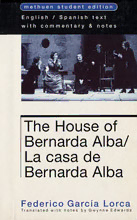
House Of / La Casa de Bernarda Alba (Methuen Student Edition) PDF
102 Pages·1998·34.593 MB·English,Spanish
Most books are stored in the elastic cloud where traffic is expensive. For this reason, we have a limit on daily download.
Preview House Of / La Casa de Bernarda Alba (Methuen Student Edition)
Description:
This Methuen edition has both the original Spanish and translated English side-by-side.Bernarda Alba is a widow, and her five daughters are incarcerated in mourning along with her. One by one they make a bid for freedom, with tragic consequences. Lorca's tale depicts the repression of women within Catholic Spain in the years before the war. Edited with invaluable student notes - a must for students of Spanish drama. ContentsFederico Garcia Lorca: 1898-1936PlotCommentary Lorca and the theatre of his time The real-life source of The House of Bernarda Alba The social background and meaning of the play The broader meaning: symbolism and imagery The characters The play as tragedy Staging of Lorca's plays in his lifetime Production history of The House of Bernarda Alba The translation The Spanish textFurther readingLA CASA DE BERNARDA ALBA - THE HOUSE OF BERNARDA ALBA Acto Primero / Act One Acto Segundo / Act Two Acto Tercero / Act ThreeNotes Wikipedia says "The House of Bernarda Alba (Spanish: La casa de Bernarda Alba) is a play by the Spanish dramatist Federico García Lorca. Commentators have often grouped it with Blood Wedding and Yerma as a "rural trilogy". Lorca did not include it in his plan for a "trilogy of the Spanish earth" (which remained unfinished at the time of his murder).[1]Lorca described the play in its subtitle as a drama of women in the villages of Spain. The House of Bernarda Alba was Lorca's last play, completed on 19 June 1936, two months before the author's murder by the Nationalists (fascists) during the Spanish Civil War. The play was first performed in 1945. The play centers on the events of a house in Andalusia during a period of mourning, in which Bernarda Alba (aged 60) wields total control over her five daughters Angustias (39 years old), Magdalena (30), Amelia (27), Martirio, (24), and Adela (20). The housekeeper (La Poncia) and Bernarda's elderly mother (María Josefa) also live there.The deliberate exclusion of any male character from the action helps build up the high level of sexual tension that is present throughout the play. Pepe "el Romano", the love interest of Bernarda's daughters and suitor of Angustias, never appears on stage. The play explores themes of repression, passion, and conformity, and inspects the effects of men upon women."
See more
The list of books you might like
Most books are stored in the elastic cloud where traffic is expensive. For this reason, we have a limit on daily download.
